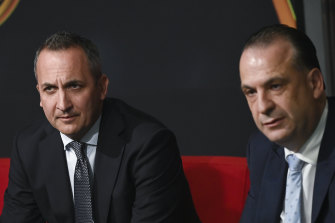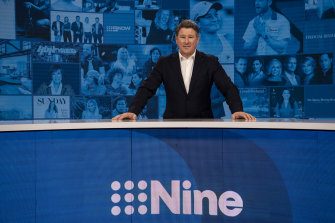It would also dramatically reshape the Australian media industry.
NRL’s complicated love triangle with broadcasters
The NRL is supported by the two biggest fish in Australian media – News Corp (through its majority owned pay TV arm Foxtel). But at various points in the code’s recent history, one of the two media partners had held the upper hand, making the scorned party furious.
In the late 1990s, News Corp’s failure to secure a pay television rights deal to broadcast the rugby league led to a lengthy legal battle between Australia’s most renowned media moguls, Kerry Packer and Rupert Murdoch. The Super League wars ended with two rugby league competitions running alongside one another in 1997 before a peace deal was struck the following year.
In 2015, after the NRL signed a $925 million five-year deal with its free-to-air partner Nine on the first day of Murdoch’s visit to Australia, it led to a vitriolic campaign against then NRL boss Dave Smith, who ended up resigning in the middle of negotiations.
The long-running tensions between News Corp and the NRL now appear to be water under a bridge since V’landys took the helm in 2019. V’landys has run Racing NSW since 2004 and as a result has had a longstanding relationship with News and its newspapers such as The Australian, The Daily Telegraph and The Herald Sun. Media industry executives often say this relationship is an important part of why Foxtel loves the NRL, again.
But while observers say the relationship between NRL and News has never been stronger, there are now question marks over the health of its ties with Nine, and how much the incumbent is willing to pay. Last year at the height of the COVID-19 pandemic former Nine boss Hugh Marks launched a scathing critique of the NRL, attacking a “bloated head office” for “years of mismanagement”. The spray was widely viewed as the catalyst for the departure of then NRL boss Todd Greenberg.

Andrew Abdo and Peter V’landys addressed the clubs on Thursday.Credit:NRL Photos
The Sydney Morning Herald revealed last week that Foxtel had agreed to hand over an additional $20 million annually over the next five years to the NRL, which will provide financial support for a 17th team based in Brisbane. That is over and above a five-year extension struck last year during the coronavirus pandemic.
In exchange for this additional payment, Foxtel will get more games involving the Broncos (which are majority owned by News Corp) exclusively for its set-top box and its streaming service, Kayo Sports.
The figure is high enough to placate the existing clubs, who have been told it will cost head office about $75 million over the same period to fund a 17th team. But the deal also shocked Nine, the Broncos are currently the only team in Australia’s third biggest city and as such considered a major ratings draw.
“You’re dead without [live sport], and you’re on life support with it. NRL, AFL, tennis, cricket- you need one of those tentpoles to be able to showcase what you’re programming”
The Redcliffe-based Dolphins are considered the frontrunners to be granted a new license ahead of bids from the Brisbane Firehawks and Brisbane Jets, based as much on the support of News Corp as on their submission.
The NRL’s new chief digital officer, Alexi Baker, last week announced a restructuring of the company’s digital arm, putting an end to its breaking news coverage. Foxtel, whose parent company News Corp publishes The Australian, The Daily Telegraph and The Herald Sun, has long complained about the division as they believe it competes with their coverage of the NRL. Former Nine boss Marks was also a critic of the NRL’s online news coverage, arguing it unnecessarily competed with Nine’s newspapers (including this masthead).
Why the NRL rights are crucial
Foxtel provides 66 per cent of the NRL’s broadcast revenue. But about two-thirds of fans watch games on free-to-air television. So while Foxtel is crucial from a revenue perspective, it is crucial for the sport to have a free-to-air television presence for the code to retain its popularity.
For Foxtel, partnering with Seven could be straightforward. The pair already have a good working relationship for sports including the cricket and AFL, and there has previously been widespread speculation about a more substantial corporate deal between the two companies. The deal would also mean Seven would be the home of the AFL, NRL and cricket as well as motorsports and racing.
Meanwhile, the NRL is considered critical for Nine, as it is one of two key sports in its lineup (the other being tennis).

Nine’s Mike Sneesby presented to the NRL last week. V’landys told the 16 clubs the meeting went well.Credit:Louise Kennerley
Under the last deal, Nine paid $575 million over a five-year period including contra (free advertising), but that deal was reduced last year due to COVID-19 related delays and restrictions. Sources have indicated that the NRL wants more than $600 million over five years under the next arrangement.
“You’re dead without [live sport], and you’re on life support with it,” media buyer Barry O’Brien, who runs independent agency Atomic 212. “NRL, AFL, tennis, cricket- you need one of those tentpoles to be able to showcase what you’re programming. It opens up many doors to finance companies, car companies, wagering companies, and without it you haven’t got that advertising revenue.”
Whatever happens, the free-to-air broadcast partner that ends up clinching the rugby league rights will not need to stump up an upfront sum. In a meeting with the chairs and chief executives of the 16 clubs on Thursday, V’landys said that price was only one of the drivers in deciding the rights. He spoke of the five ’P’s; price, participation, product, promotion and partnership.
It’s clear the NRL will seek more input into how its product will be presented in the future, but that won’t be the only departure from how previous deals have been structured.
Previously, both Foxtel and Nine have paid the NRL a large percentage of its money in advance. When the COVID-19 outbreak shut down the competition last year after just two rounds – with no guarantee that it would restart again – Nine initially demanded that its advance be returned (the issue was resolved when it renegotiated its existing broadcast deal).
The NRL had hoped the disruptors – the likes of Netflix, Amazon and Disney – would create competitive tension in the latest negotiations. However, the league recognises the need to partner with an FTA provider to reach the largest possible audience. Further, Nine and Foxtel currently wear the $50 million in production costs themselves; the NRL would have to pick up that tab if it were to provide the finished product that the disruptors would demand.
NRL chief executive Andrew Abdo and V’landys would like to announce a free-to-air broadcasting partner by the end of the month.
V’landys has longstanding relationships with media executives across the country which he leverages to drive hard bargains. His private room at The Everest this weekend will illustrate this point: News Corp executive chairman Michael Miller, Foxtel’s Delany, Nine’s boss Sneesby and Seven’s Warburton are all expected to attend.








